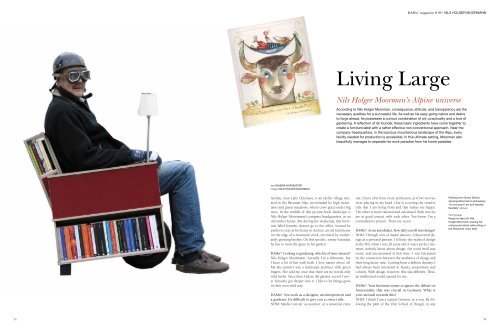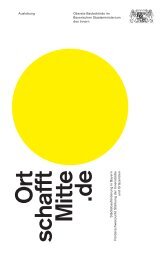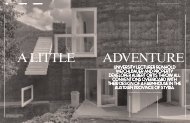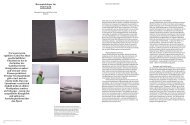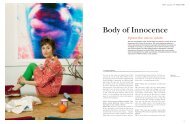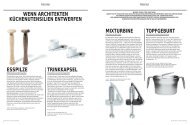Living Large - SandraHofmeister
Living Large - SandraHofmeister
Living Large - SandraHofmeister
You also want an ePaper? Increase the reach of your titles
YUMPU automatically turns print PDFs into web optimized ePapers that Google loves.
text saNdra hofMEistEr<br />
images Nils holGEr MoorMaN<br />
Aschau, near Lake Chiemsee, is an idyllic village situated<br />
in the Bavarian Alps, surrounded by high mountains<br />
and green meadows, where cows graze under big<br />
trees. In the middle of this picture-book landscape is<br />
Nils Holger Moormann’s company headquarters, in an<br />
old timber house. But during the weekends, this furniture<br />
label founder doesn’t go to the office, instead he<br />
prefers to stay at his home in Aschau, an old farmhouse<br />
on the edge of a mountain creek, encircled by exuberantly<br />
growing bushes. On this specific, sunny Saturday,<br />
he has to mow the grass in his garden.<br />
DAMn°: Cooking or gardening, which is of more interest?<br />
Nils Holger Moormann: Actually I’m a dilettante, but<br />
I have a lot of fun with both. I love nature above all.<br />
My late partner was a landscape architect with green<br />
fingers. She told me once that there are no weeds only<br />
wild herbs. Since then I adore the garden, even if I never<br />
honestly got deeper into it. I like to let things grow<br />
in their own wild way.<br />
DAMn°: You work as a designer, an entrepreneur and<br />
a gardener. It’s difficult to give you a correct title.<br />
NHM: Maybe I am an ‘occasionist’, or a universal crazy<br />
nut. I have a bit from every profession, as if two movies<br />
were playing in my head. One is covering the creative<br />
side that I am living from and that makes me happy.<br />
The other is more rational and calculated. Both movies<br />
are in good contact with each other. You know, I’m a<br />
contradictory person. That’s my secret.<br />
DAMn°: As an autodidact, how did you roll into design?<br />
NHM: Through a lot of insane detours, I discovered design<br />
as a personal passion. I fell into the realm of design<br />
in the 80s, when I was 28 years old. It was a perfect moment:<br />
nobody knew about design, the word itself was<br />
exotic and unconsumed at that time. I was fascinated<br />
by the connection between the aesthetics of things and<br />
their long decay time. Coming from a fashion dynasty, I<br />
had always been interested in beauty, proportions and<br />
colours. With design, however, this was different. Thus,<br />
an intellectual world opened for me.<br />
DAMn°: Your furniture seems to ignore the debate on<br />
functionality that was crucial in Germany. What is<br />
your attitude towards this?<br />
NHM: I think I am a typical German, in a way. By following<br />
the path of the Ulm School of Design, in any<br />
DAMn° magazine # 29 / Nils holGEr MoorMaNN<br />
<strong>Living</strong> <strong>Large</strong><br />
Nils Holger Moorman’s Alpine universe<br />
according to Nils holger Moorman, consequence, attitude, and transparency are the<br />
necessary qualities for a successful life. as well as his easy-going nature and desire<br />
to forge ahead, he possesses a curious combination of wit, practicality and a love of<br />
gardening. a reflection of its founder, these basic ingredients have come together to<br />
create a furniture label with a rather effective non-conventional approach. Near the<br />
company headquarters, in the luscious mountainous landscape of the alps, every<br />
facility needed for production is accessible. in this ultimate setting, Moorman also<br />
beautifully manages to separate his work paradise from his home paradise.<br />
Painting from simon dittrich<br />
showing Moormann’s philosophy:<br />
‘on one point i am bull-headed:<br />
flexibility’ (above)<br />
Facing page:<br />
ready for take-off: Nils<br />
holger Moormann wearing his<br />
motorcycle helmet while sitting in<br />
the ‘Bookinist’ chair, 2007<br />
32 33
DAMn° magazine # 29 / Nils holGEr MoorMaNN<br />
From left to right:<br />
Explaining the use of things, Nils<br />
holger Moormann plays with<br />
furnishings and identities<br />
the captain’s darling ‘Es’ (1999)<br />
designed by Konstantin Grcic<br />
soccer kick à la Moormann: inside<br />
the photo studio in the office attic,<br />
the fNP shelving by axel Kufus<br />
becomes the goal<br />
caesar’s triumph atop of the<br />
‘sparondo’ table (2003) designed<br />
by Jakob Gebert<br />
case, you cannot fail. But in my eyes, there is an important<br />
aspect to add. A collection must not be too correct.<br />
A bit of a wink and some humour is necessary, even to<br />
treat materials in a strong and sincere way. I’m happy<br />
that our furniture is not too perfect and rigid. In the<br />
end, things still have to be alive.<br />
DAMn°: Most of your furniture is fabricated in plywood<br />
or MDF. Can you tell us about your experiences<br />
with this material?<br />
NHM: We do not have our own fabrication facilities.<br />
We produce everything within a radius of 30 kilometres<br />
from our office in Aschau. I don’t like keywords like sustainability<br />
or ecology, but in my opinion there is no sense<br />
in sending things across the world, back and forth, to<br />
distribute them. My dream has always been an extended<br />
workbench, where you could realise projects together<br />
with craftsmen. By using plywood and MDF, we are very<br />
much concerned with the question of surfaces. Personally,<br />
I don’t like it when surfaces are completely closed<br />
and don’t give an idea of their substrate. Over the years,<br />
working with plywood planks thousands of times and<br />
more, we have discovered their spirit.<br />
DAMn°: There are several pieces like the Bookinist that<br />
you developed on your own. Do you see yourself as a<br />
designer?<br />
NHM: I’m not a designer, even if I play with things and<br />
think about all sorts of nonsense. The Bookinist is an<br />
example of that attitude. I built it for myself because<br />
I needed a seat for reading and wanted an alternative<br />
to those uncomfortable upholstered armchairs. For the<br />
Milan furniture fair we were looking for something on<br />
which people could sit down at the stand, so we spontaneously<br />
decided to build two more Bookinists. Suddenly<br />
we received many requests for this chair, which<br />
had not been planned for production. I am not proud<br />
of my design, personally. I consider it rather childish.<br />
My part is more the one of consultant, who has experiences<br />
with different ingredients and might know how<br />
things can work.<br />
DAMn°: Until recently there was not a chair in your<br />
collection, but now there are two of them. Where does<br />
this change come from?<br />
NHM: It is not the product itself that I was keen to develop.<br />
Chairs are the most difficult things to produce,<br />
because they have to bear this cruel, static, incorrect<br />
way of sitting, on the one hand –when your boyfriend<br />
sits on your knees, for example… And on the other<br />
hand, there is a very constrained market for chairs. In<br />
fact there are billions of them, but in the end it’s always<br />
the same ones that are sold. I wanted to avoid the production<br />
of chairs, actually.<br />
Anyway, I fell in love with the Pressed Chair and the<br />
Zipfred. They are so radical and responsible that I had<br />
to smirk first and then I had to bow in respect of their<br />
concepts. I knew that the Zipfred was not really a serious<br />
project. But I found it very important to convey<br />
the concept behind this. The Pressed Chair, however,<br />
corresponds exactly to my philosophy, making the<br />
best possible out of the least possible. Reducing until<br />
the very end –that’s for me a classical invention. If we<br />
really can produce the chair, as planned, that will be<br />
wonderful.<br />
Presentation of 11 novelties at the Moormann stand, salone del Mobile 2011<br />
– some of them were hidden and given promising titles as a joke (left)<br />
invitation to the salone 2011: Nils holger Moormann thought it would be a<br />
grandiose idea to visit the exhibition without a new wardrobe (above)<br />
12. – 17. aprile 2011<br />
Salone Internazionale Wardrobe del looking Mobilefor<br />
a wall to lean-on, for mutual hanging around: lodelei<br />
Padiglione 20<br />
wardrobe, designed by Martin Pärn and Edina dufala Pärn, 2011 (bottom, left)<br />
Posto F18<br />
Nuova Fiera Rho Pero<br />
5 bars and one tabletop: Minimato, designed by Matthias ferwagner, 2011<br />
(bottom, middle)<br />
Pure function, outside and inside: Pressed chair, designed by harry thaler,<br />
2011, is made from a single sheet of metal, stabilised by its form and<br />
circumferential depression (bottom, right)<br />
34 35
DAMn° magazine # 29 / Nils holGEr MoorMaNN<br />
Clockwise:<br />
Gespanntes regal (1984) by Wolfgang laubersheimer. the<br />
characteristic steel cable is not a decoration, but provides the<br />
necessary tension and stability for the shelf to remain upright<br />
hut ab (hats-off) (1998) by Konstantin Grcic is a wardrobe that<br />
can be folded together, stored in a minimum amount of space,<br />
and suspended in a number of ways<br />
insert coin (2010) by Neuland can be individually configured<br />
in many different ways. the trays can be inserted into the wall<br />
panel in any order<br />
Gardening with the Kant desk (2002) designed by Patrick frey<br />
and Markus Boge<br />
Facing page, from left to right, top to bottom:<br />
abgemahnt (2007) is a side table designed by Nils holger<br />
Moormann. it can be moved easily using the hoop that divides<br />
the tabletop asymmetrically and serves as a handle<br />
the 50 family (2009) by thomás alonso consists of trestles<br />
of different heights. With their third leg to stand on, these<br />
untreated oak supports can be used as high and low stools –<br />
or to support a tabletop<br />
Else (2010) by Urban schnieber is a shelf made of birch<br />
plywood with no need for screws, brackets or props. the<br />
drawer height can be individually selected and the side panels<br />
lean to either side – creating new forms time and again<br />
Easy reader (2009) by Nils holger Moormann is a piece of furniture<br />
for those who love reading. there is a small seat on which to relax<br />
and space for books, plus it can be positioned wherever desired<br />
Egon (2010) by franz Volhard has no screws. the ash wood frame<br />
requires no connecting elements and can be easily assembled<br />
der keline lehner (2003) by Jörg Gätjens: this standing desk<br />
can be leant against almost any wall or shelving, and provides<br />
a surface for books. arranged with a third leg, it becomes<br />
a freestanding furniture element<br />
zipferd (2010) was designed by Viktor Matic, a product design<br />
student at Bozen-Bolzano. the chair consists of 6 wooden<br />
elements and 20 layers of cardboard, held together only by<br />
connecting cable ties. Each piece has its very own character<br />
dresscode (2004) by Jörg Boner is a room divider and a cabinet,<br />
built within minutes. it is lightweight and of minimal packaging<br />
size. the side panels are fixed in place by a frame in ash wood<br />
Yak (2010) by rupert Kopp: a wardrobe made of ash wood<br />
and steel<br />
36 37
DAMn° magazine # 29 / Nils holGEr MoorMaNN<br />
Top, from left to right:<br />
the headquarters in aschau<br />
near chiemsee, is situated in a<br />
traditional house – the former<br />
‘festival hall’ of the village<br />
the hall of fame shows all design<br />
prizes in an overhead loop<br />
the idyllic Bavarian company<br />
façade and, behind it, the<br />
postmaster’s office on the first<br />
floor of Moormann’s headquarters,<br />
made of ‘Postmeister’ fNP<br />
shelving<br />
Unusual logistics: The furniture is<br />
manufactured by the producers of<br />
local crafts – and transported to the<br />
nearby logistics centre by tractor<br />
DAMn°: You have a very clear philosophy for leading<br />
a company. What is it exactly?<br />
NHM: There are three important aspects: consequence,<br />
attitude, and transparency. If you follow<br />
these aims in your life, you will not fail. Many people<br />
misunderstand the making of furniture, they want to<br />
make money instead. But in this constellation there is<br />
something important missing: to make people happy.<br />
The crème fraiche design became an attitude within<br />
the design world. Do you know what this is? Someone<br />
who does not know how to cook takes crème fraiche<br />
for everything, and it works somehow, even if it disguises<br />
the original taste. The same effect exists in the<br />
design world. With ingredients like crème fraiche, a<br />
company can work in some way. But the goal is to<br />
understand things, to approach them until they begin<br />
to light-up from the inside out.<br />
DAMn°: How do you develop ideas – from your own<br />
needs?<br />
NHM: Strangely enough, there are periods where I have<br />
many ideas. When I have to go for long business trips,<br />
my colleagues sometimes stick a post-it note in the car,<br />
wishing me a good trip with no jams at all. That’s because<br />
I begin to sketch when I am stuck in a jam, and to think<br />
about new projects. I don’t know how to sketch, and my<br />
problem is to find a way to make my ideas clear to others.<br />
DAMn°: About aspects of money – it almost seems<br />
like money has no role at all for you?<br />
We all think too much about money. Of course it is important<br />
for a company. But if you evaluate everything<br />
only from the financial point of view, you will destroy a<br />
lot. Dreams are so vulnerable! You have to admit them,<br />
follow them, even if you might fail. To achieve this freedom,<br />
we operate strictly economically in other domains.<br />
In Milan during the Salone, for example, our whole team<br />
stays not in a hotel but at a campsite a bit outside the city.<br />
Thus we save some thousands of euros that we can then<br />
spend on making another fancy catalogue.<br />
DAMn°: This year at your stand in Milan, you presented<br />
11 novelties, all covered with white fabric and<br />
announcements about the upcoming years. What’s<br />
behind this joke?<br />
NHM: That was great, wasn’t it? We showed a light called<br />
La Funsel from Giacomo Illuminati, scheduled for 2018.<br />
‘The burner’ was the fire extinguisher, obligatory for every<br />
stand – we put it on a platform, like a sculpture. I want to<br />
have fun during a fair. There is nothing more boring than<br />
furniture, furniture and furniture again. I want to be inspired<br />
instead, I want to see people, make contact with interesting<br />
ideas. The rest is hard work and serious business.<br />
But that comes all by itself. Life is brutal enough for that. #<br />
www.moormann.de<br />
The Pierre Bleue du Hainaut ® ,<br />
The blueprint for great ideas<br />
Life-enhancing Pierre Bleue du Hainaut offers far more than timeless beauty.<br />
Extracted in Belgium, and transformed by local stone massons, the Pierre<br />
Bleue du Hainaut is a truly 100% Belgian quality product.<br />
For interiors and exteriors, it resists everything everyday usage throws at it,<br />
yet requires very little upkeep. Ecological and sustainable by nature, it adds<br />
value to your projects by bringing your ideas to life with consummate style.<br />
Stay up-to-date with the Pierre Bleue du Hainaut, find new inspiration, and<br />
benefit from practical advice, all on our website created especially for you.<br />
www.cdhpro.be<br />
38 39<br />
www.sizecommunication.com


